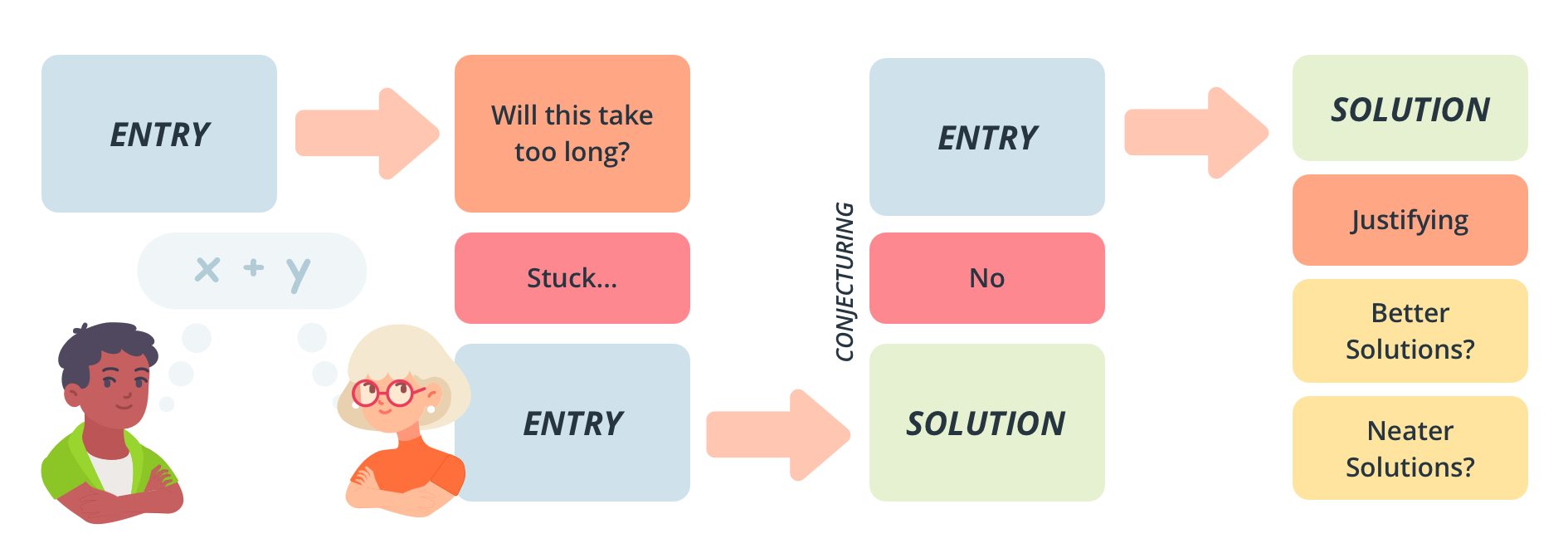3 Attack

The attack stage involves our attempts to solve the problem and build a model, or to determine a method for solving it.
It often helps to test some initial hypotheses or use some example values so that we can better understand the underlying mechanics of the problem and whether or not we are missing information (this might have also been established in the Entry stage).
Attack strategies
The attack phase constitutes our attempts and working to solve the problem. It’s often tempting to just jump straight to this phase without doing enough work in the entry and sometimes this can pay off – especially if it’s not a ‘real’ problem (or if we’re really lucky). But if you’ve spent time solving a problem before you are probably aware that this stage involves much more than just doing some sums and seeing what you come up with.
Specialising and Generalising
There are two sets of processes surrounding the attack that can lead us toward a final solution. As we begin, we have the process of specialising. This usually means choosing a special case. We might try randomly at first, for example, with the handshake problem, we can just draw 5 people and count the handshakes, then 3 people and see if there’s any connection. With the Huashan cliff-face, we might first see what happens when we make three moves, or we might try a simpler version where there’s only 2 people on each side.
This is fine for getting a handle of the problem and how the mathematics works, but we might then start being systematic. In the case of handshakes, we can try with one person, two people, three people in order and look for the pattern.
For some problems, we might also be systematic to eliminate certain cases. With the cliff-face, we only have a limited number of moves, individuals moving across or individuals jumping, we can list the moves and work out which ones lead to dead-ends.
However then eventually we might also start specialising ‘artfully’ – what is meant here is that we try specific test cases that will provide specific information. This type of specialising usually comes when we have a conjecture that we want to test out.
For example, we might have a rule for the number of handshakes, and we want to see if it works for 1 people or 0 people, or even 100 people.
What we’re usually working towards is a general rule, so while it might be good to know how many handshakes there are for 20 people, we’d much rather a general result that will always work. We might even generalise further to the case of both left and right hand-shakes, or to include self-shakes – extending the problem parameters beyond to make our finding as useful as possible.
Conjecturing and Justifying
The process of conjecturing and justifying can be articulated in terms of different levels of scepticism.
We start with a conjecture, for example,
Is the number of handshakes equal to two times the number of people?
We check the conjecture on different cases – either building our case or determining that it is false. We then might try to find specific cases that refute it, for example when we try odd cases like 1 person or even 0 people to see if the solution we found works.
We want to get a sense of why it is right, or modify it so that it is right.
One way of thinking about it is to first convince yourself, then imagine you are trying to convince a friend, and finally, imagine trying to convince an enemy – well perhaps not an enemy, but someone who likes to be annoying and disagree with you and will exploit any inconsistency in your thinking!
With that in mind, let’s take a look at some of the main strategies you can employ to solve problems.
| Strategy | Strengths | Weaknesses |
| Trial and error (sometimes referred to as exhaustive search or brute force attack) | Good if there are only a finite number of possibilities.
Good if the “error” can inform the next guess (e.g. higher/lower) |
Time consuming.
Not very elegant. Can’t usually adapt such models to new situations. |
| Simplify the problem | Can help to understand the dynamics of the situation
We might identify patterns Solution to the simplified problem can give a rough idea of what the solution/model should be in the more difficult case |
Elements we remove or simplify may be the crucial elements of the actual problem |
| Draw a diagram/graph, act out the situation | Representing the problem visually or acting it out can help make sense of the problem
Graphs can provide important information that is easier to interpret
|
Solutions may not always be accurate
Models that involve the drawing of a diagram could be time-consuming or difficult to construct |
| Use a table / Look for a pattern | Organising the information in a readable and organised format can help us see patterns
|
Some mathematical patterns may not become apparent
Sometimes tables can overwhelm us with information |
| Work backwards | Sometimes results in a sequential process with no ‘dead ends’ or need to startover | Thinking backwards is sometimes conceptually more difficult |
| Develop algebraic or simulation models | Usually adaptable to new situations
Can generate results quickly |
If the model is too complex, can be difficult to explain to others
Getting in the habit of solving everything algebraically can blind us to simpler and more elegant solutions |
Considerations during the Attack phase
The attack phase can be frustrating or rewarding and is often both. As you work through a problem, it’s important to recognise that you will go back and forth between the entry, attack and generalising phases often until you are confident you can justify your solution.
Feeling lost is a normal part of the process. Don’t worry, it certainly does not mean you’re not good enough and is no reflection on your intelligence or ability. Trust us, even people with PhDs in mathematics can feel lost when trying to solve problems using mathematical reasoning.
As you practice problem solving, you will develop your intuition around which strategy might work in a certain situation and how far or long to persevere with a method before you consider it a dead end.
Here are some things to keep in mind while you’re working through the problems listed in the next chapter.
Textbook answers don’t give the whole story
It’s a good thing to learn from – and employ the knowledge you’ve gained from – traditional textbooks that focus on mathematical methods. The more methods you know, the more tools you have at your disposal. However, we need to keep in mind that the process of solving real world problems is often quite different to the process of solving textbook problems.
It’s a pity that most example questions and answers we’re given in some textbooks (even to problem solving problems) don’t realistically model the process of entry and attack. We might build up the idea that the attack phase simply involves working away with our chosen method, after which we reach the solution and the problem is solved. If we get a different answer to the back of the book, all we need to do is look back over our working.

Problems that can be solved using mathematical reasoning in the real world are rarely like this and if it is, it’s probably more of a routine problem than a problem solving problem.
An attack usually involves multiple attempts, returning to the entry, trying again, re-treading old ground. We might start working it out in one way, but then realise that either this won’t work or will take too long! We start to find patterns and we make conjectures, but then sometimes those conjectures turn out to be false and need reworking – then even once we’ve reached a solution, we may need to try even more methods in order to justify the conclusion we reached.
In the end, we might arrive at a good looking, aesthetically pleasing solution, and it’s this solution that we present – often deceptively much simpler than the difficult process we embarked upon.

So the attack phase involves trying out ideas, looking for patterns, asking ourselves why those patterns are occurring, determining whether or not they can be expressed with a neat and concise rule, making conjectures, confirming the conjectures, perhaps changing our point of view, ensuring that we’re not missing some piece of information, or even investigating why certain approaches did not work. And it is in this phase that we are most likely to find ourselves stuck.
Getting stuck (and unstuck)
It’s ok to be stuck. Whether it’s a mathematics problem, or even a computer game, we’ve all experienced the state of being stuck. But being stuck is okay – in fact being stuck is referred to in Thinking Mathematically as “an honourable state” (Mason, Burton & Stacey, 2010, p. 45).
There are some good things about being stuck.
Don’t give up just yet…
Firstly, it means we’ve engaged with the problem and we haven’t given up on it yet – because if we’ve abandoned the problem then we’re no longer stuck, and if we don’t care about the solution then we’re probably not feeling that stuck either. However, if we give up too soon we might have missed an opportunity to learn from that state.
It is only from being stuck and accepting it is possible to learn how to get unstuck that we can overcome problems. In fact, some of the greatest results in mathematics have arisen after either a collective or individual period of being stuck.
So, if you are stuck – acknowledge it, make a note of it in fact. But even more importantly, much later on, take the opportunity to reflect on how you became ‘unstuck’. Although we all might do it, being negative is not productive – it’s simply not true that the state of being stuck is some reflection on our intelligence or even ability at mathematics.
Try to stay productive
Accepting the state of being stuck does not mean persevering with the same method we’ve been trying or just randomly leaping to another. Continuing with a bad strategy won’t help.
We can examine the reasons we are stuck: are we making certain assumptions? At this point, we might even think back to the times when we were stuck and why. Sometimes lessons and insight can come from unexpected places.
Should I cheat?
Of course, we sometimes have the option to “cheat” too. The internet is fantastic for this. And, indeed, this might be preferable to spending days on something that we’re not ready to solve. But even if you do choose to ‘cheat’, make sure you use the experience as a learning opportunity.
It shouldn’t just be about how another person chose to solve the problem, but rather what was it that stopped us from seeing this path to the solution:
- Were we under a false assumption?
- Was there mathematics involved that we hadn’t considered (or was it actually beyond what we could have expected from ourselves)?
- Now that we have a solution – can we see whether our methods could eventually get there? Can we work using another approach?
Try something else
In terms of different attack approaches, it’s good to be open to different methods.
Once we become confident using a powerful method for problem solving such as algebra, we can become over-reliant on it and this sometimes blinds us to more simple, elegant and intuitive solutions.
References
Mason, J., Burton, L. and Stacey, K., 2010. Thinking Mathematically Secon Edition. England: Pearson Education Limited.

